“Doe” (2016)
Freehand sketch with pencil. This illustration was done to practice drawing a type of hairstyle. Other notable aspects include the piercings, eyeliner, heart-shaped mouth, and linework on the collarbones and neck.
More from this Category:
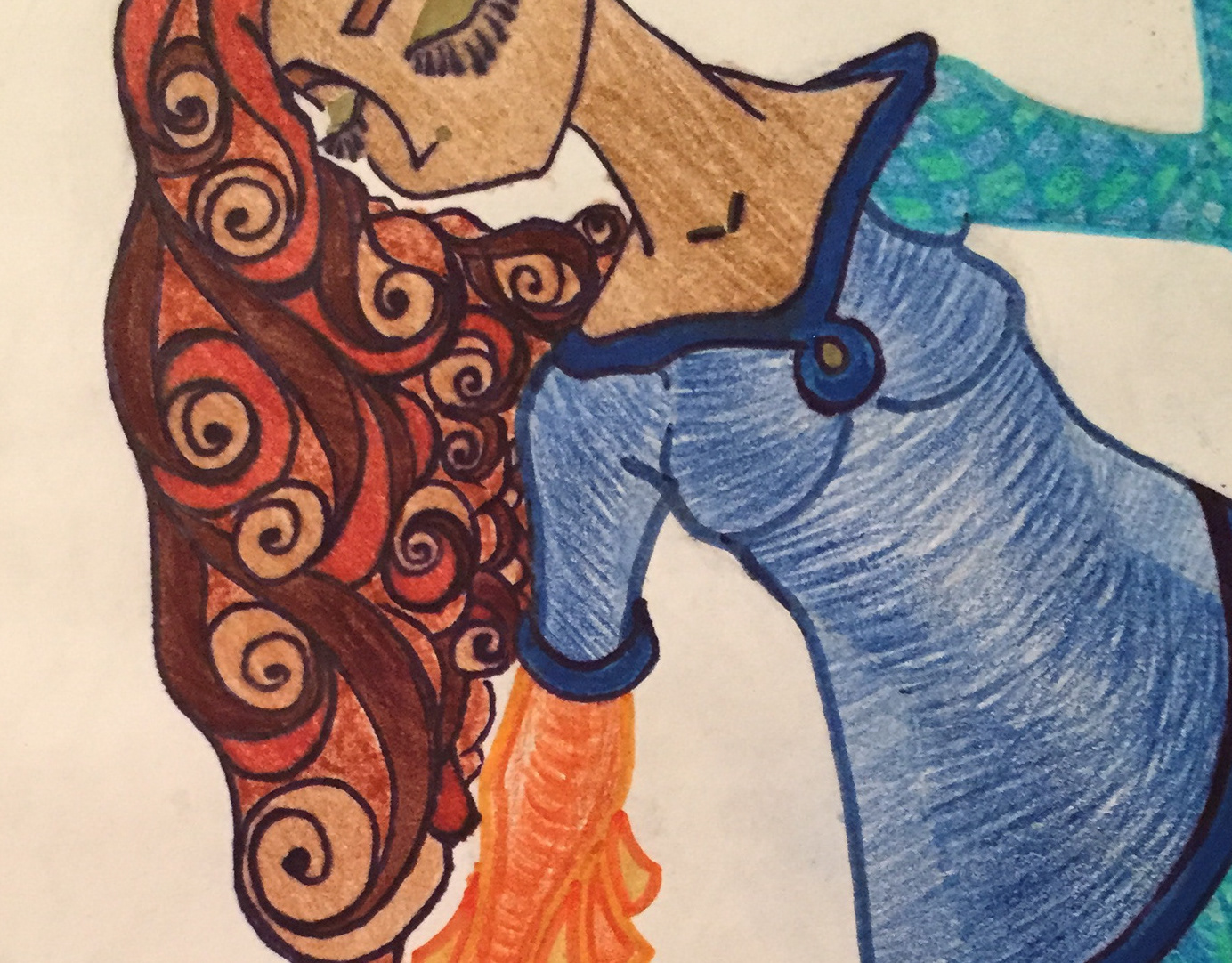
“Alchemy" (2014)
Drawn with colored pencil, pencil, and ink. The figure study is provided in the center image, the full draft is the image on the right, and the final image is on the left. An undercut style hairstyle, along with rich curls, auburn eyebrows, thin eyelashes, and contrasting fabrics were the focus of this piece. The shape of the body was brought out with shading. The hands were drawn stylistically, with curled golden shapes indicating some enchantment.
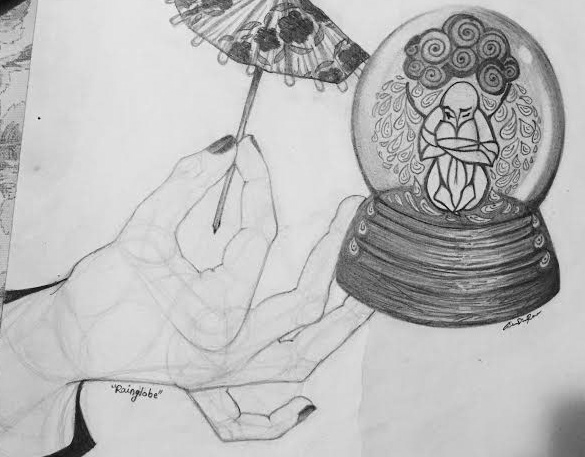
"Rainglobe: Trapped Angel" (2016)
Illustrated with pencil for a Drawing class assignment, in which students were instructed to create a piece that incorporated a hand, an object, and glass. Thus, this illustration is of a small, isolated, angelic figure trapped in a globe. A raincloud in the globe showers onto them, and the feathery drops turn into wings. Hence, the title of the piece. Meanwhile, outsiders attempt to offer comfort, represented by a hand holding a cocktail umbrella up to the glass. However, their efforts are futile; the figure is beyond their reach, and it will take more than a frail umbrella to shatter the glass. The figure, drafted in the second image below (you'll see it when you scroll down), has wrapped their limbs into a near-fetal position. They peek out at the hand, at the comfort being offered, but do not engage with it. Note the use of shading in the glass and wooden base of the globe, the high contrast of the figure's outline, a spot of light upon the glass, and the mechanical drawing style of the hand which breaks it into its simplest forms.
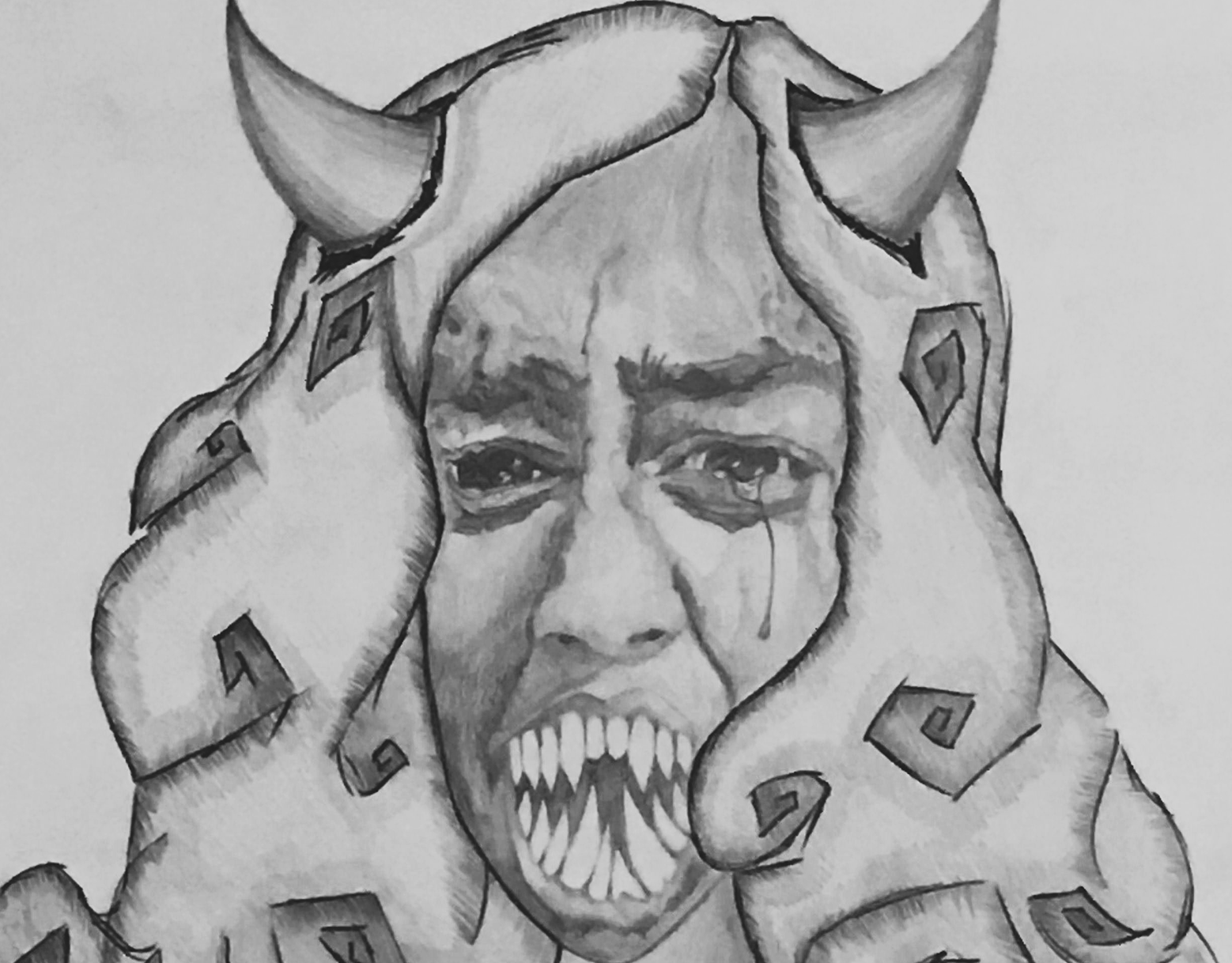
"Grendel's Mother: Self-Portrait" (2016)
Drawn in pencil with minimal use of ink. This piece was inspired by a reading of the English epic poem "Beowulf." As part of a project to understand the character of the monster Grendel's mother, this piece was created. It was based on a photo taken by the artist of herself; from there, the image takes on a fantasy theme, with fangs, horns, and serpantine, curled hair. The idea for the piece was to disrupt the viewer's sense of Grendel's mother as being purely a monster. Here, she is shown to be a tearful mother in mourning, horrified at the death of her son. She screams through her pain and the path of a dark teardrop from her eyes is captured. The viewer is meant to feel discomfort at the human emotion in the eyes of what is otherwise an inhumane, terrifying being. Thus, this illustration forces the viewer to acknowledge her humanity, rather than simply reducing the female character into a villainous or seductress stereotype. Hence, the more humane parts of her (most of her face, especially her nose, eyebrows, and eyes) are shown in a detailed, realistic style, while the more fantastical parts of her are shown in a simple, surreal style (her horns, fangs, and voluminous hair). Note the enlarged pupils, the sharp fangs, and depth of shadow on her face, horns, and neck. An image of the draft version and the attempt to find angles in the breakdown of her face is provided below (scroll down).

"War Goddess: Durga" (2016)
Drawn in pencil. This illustration is of the Hindu goddess of war and power, Durga Devi. The intention was to present the goddess with features that align more closely with that of everyday Indian women, like dark undereye circles, brown skin, and thick eyebrows, while maintaining the classic depiction of the goddess. The lion she rides into battle is drawn in a stylistic manner rather than a realistic manner to emphasize his thick mane and fearsome expression. Her golden crown and jewelry are filled with intricate detail, her third eye represents her inner vision, and two lotus flowers are tucked behind her ears. She is shown with ten arms to symbolize her ability to multitask and handle multiple weapons at once. These weapons include: a trident, a scythe, a chakra (discus), an arrow, an axe, a noose, a bow, a spear, and a shield. She holds a snake to represent her conquering death (snake = symbol of death, poison). A tiger's skin is tied around her waist, and she wears a patterned sari. Note the shading contrasts between different parts of the illustration, such as on her forearms and in the lion's mane. Her hands are drawn in a stylistic manner, with enough space between each arm. The tilt of her trident cuts across the drawing, creating a line which is kept in parallel by her outstretched leg, and there is a halo behind her head.
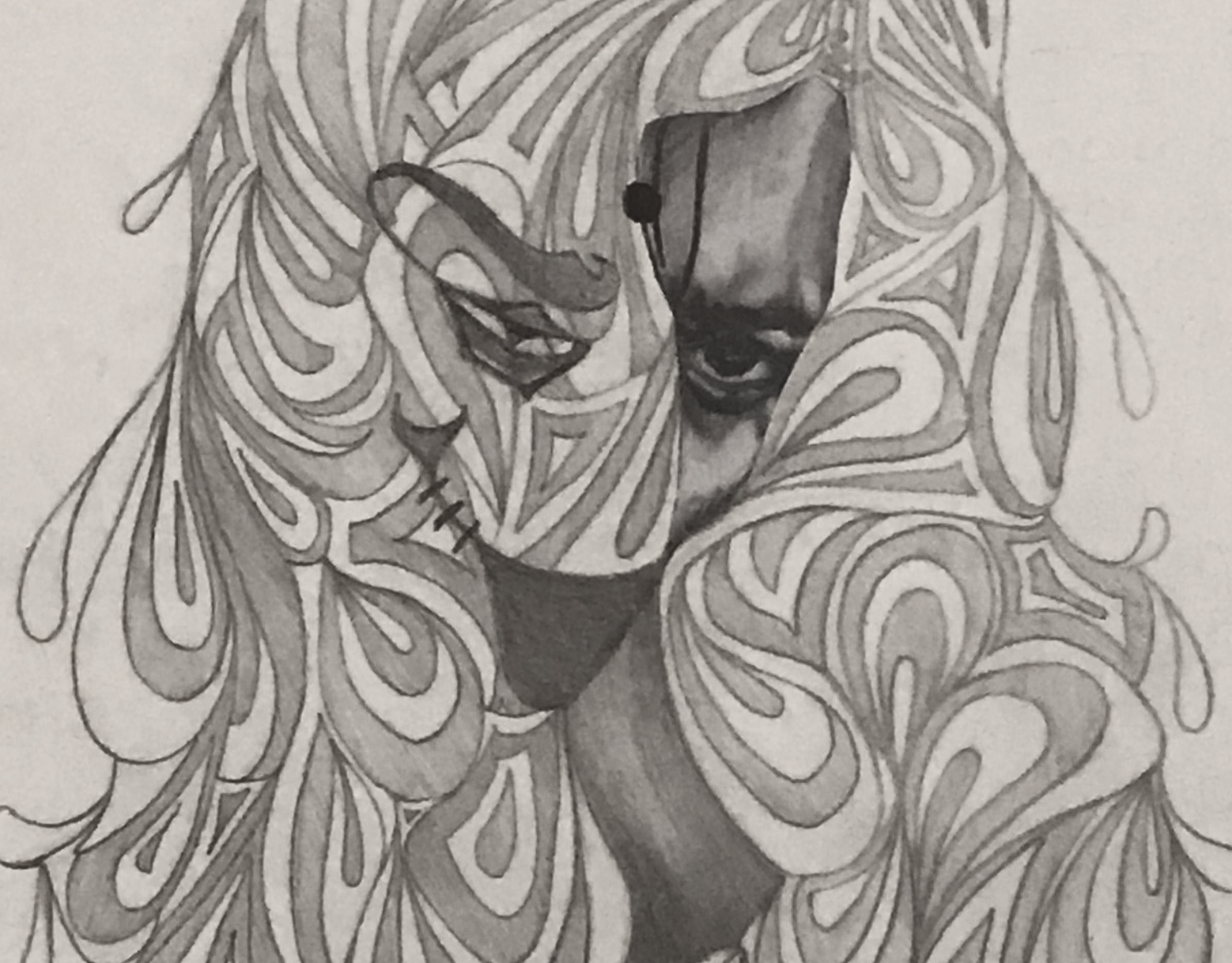
"Outer Animal, Inner Anguish" (2016)
Pencil drawing created for Drawing course. Displayed at Anglo-American School of Moscow. Realistic sliver of a face shows a tortured inner self, fighting for control inside the mind of a monstrous external self, shown with the cartoonish outer eye and stitched smile. A bindi/bottu holds both the external and internal self together, at the seams. The hair is drawn stylistically, with fluid shapes and slight curves fitted next to triangles.

"Self-Portrait in St. Petersburg" (2015)
Freehand pencil sketch using 4B and HB pencils. Drawn on a train from Moscow to St. Petersburg, with focus on blocks of unblended shadows and looser, flowing shapes. The goal was to blend realistic and surrealistic styles between face and hair. The linework outlining the profile purposefully thins and thickens to create delicacy.
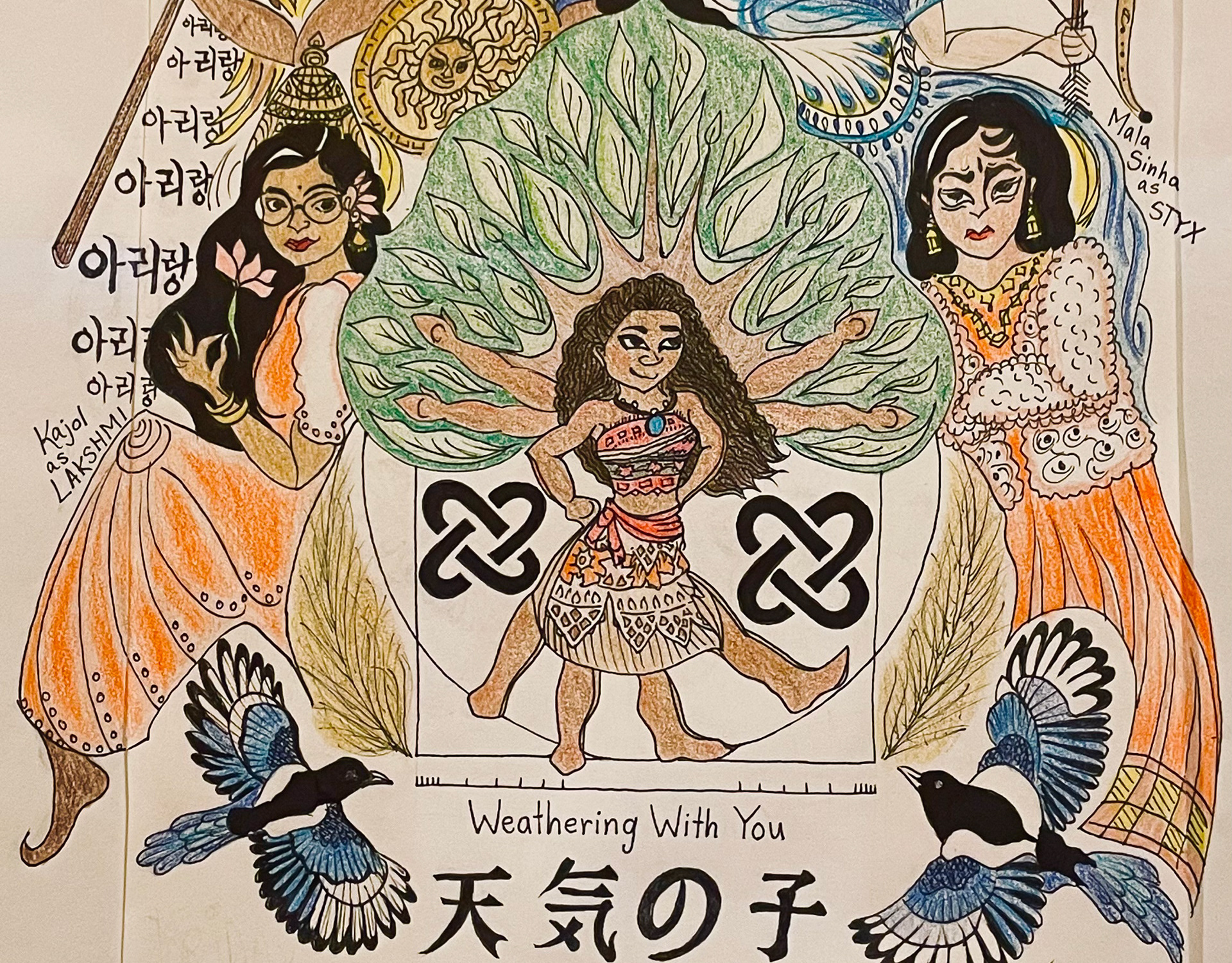
“Flute Choir: Spring Concert" (2023)
Drawn with ink and colored pencil. Goal of the design was to showcase multi-cultural unity between symbolic figures from historic art, music, mythology, and film- this aligned with the showcase theme of bringing diverse music to the flute choir group. (From center to outward layers) Moana, a Polynesian princess from Disney's film "Moana" stands center, since "How Far I'll Go" was being performed. She poses with with two extra sets of limbs, at the center of a square and circle, with a line and short marks, all drawn in a nod to the famous "Vitruvian Man" drawing by Italian artist Leonardo da Vinci, to represent human anatomy. Her arms make up the branches and her legs make up the roots of a tree, representing nature. So, this combination was meant to show Human + Nature = Human Nature, since "Human Nature" by Michael Jackson was being performed. On her right and left, there is a symbol of "Unity" or "Umoja" from the seven principles of the African holiday of Kwanza, since "Umoja," composed by Valerie Coleman, was being performed. Excerpts from the OST of a Japanese animated film, "Weathering With You" were being performed, so the title was written in English and Japanese at the bottom, while a character (wearing a red bow and yellow boots) was drawn at the top of the page. Three Korean folk songs were represented: "Blue Bird" was shown in two Korean blue birds, which carry special symbolism; "Gold Grass" was shown in two bunches of the plant on either side of Moana's tree; and the word "Arirang," from the Korean patriotic song of the same name, was written on the left side. 1. "Mala Sinha as STYX" represents the sullen character played by the actress Mala Sinha in the 1963 Hindi film "Gumrah." "Tujhko Mera Pyaar Pukaare" from that film was performed, alongside Thomas Whitman's "Styx: Goddess of the River Styx and Personification of Hatred." 2. "Jaya Bhaduri as ARTEMIS" represents the heartbroken character played by the actress Jaya Bhaduri in the 1973 Hindi film "Abhimaan." Her song, "Tere Mere Milan" was performed alongside Thomas Whitman's "Artemis: Goddess of the Hunt." The Greek goddess thus has a bow, arrow, and quiver, while wearing a sari. 3. "Bhagyashree as ATHENA" represents the actress Bhagyashree in the 1989 Hindi film "Maine Pyar Kiya." The song "Dil Deewana" was performed alongside Thomas Whitman's "Athena: Goddess of Wisdom." Hence, she wears the costume of her character along with the helmet, spear, Medusa shield, and owl symbol of the Greek goddess Athena. 4. "Kajol as LAKSHMI" represents the lovestruck character played by the actress Kajol from 1995 Hindi cult film "DDLJ." Her song, "Tujhe Dekha Toh" was performed alongside "Flower Duet" from the French musical "Lakmé." Since "Lakmé" is the French word for "Lakshmi," the Hindu goddess of beauty and wealth, Kajol is dressed in the clothes of her character along with the lotus and ornaments of Lakshmi. Hence, the cultures that are featured in this piece include: Polynesian, African, American, Italian, Japanese, Korean, Greek, Indian, and French.
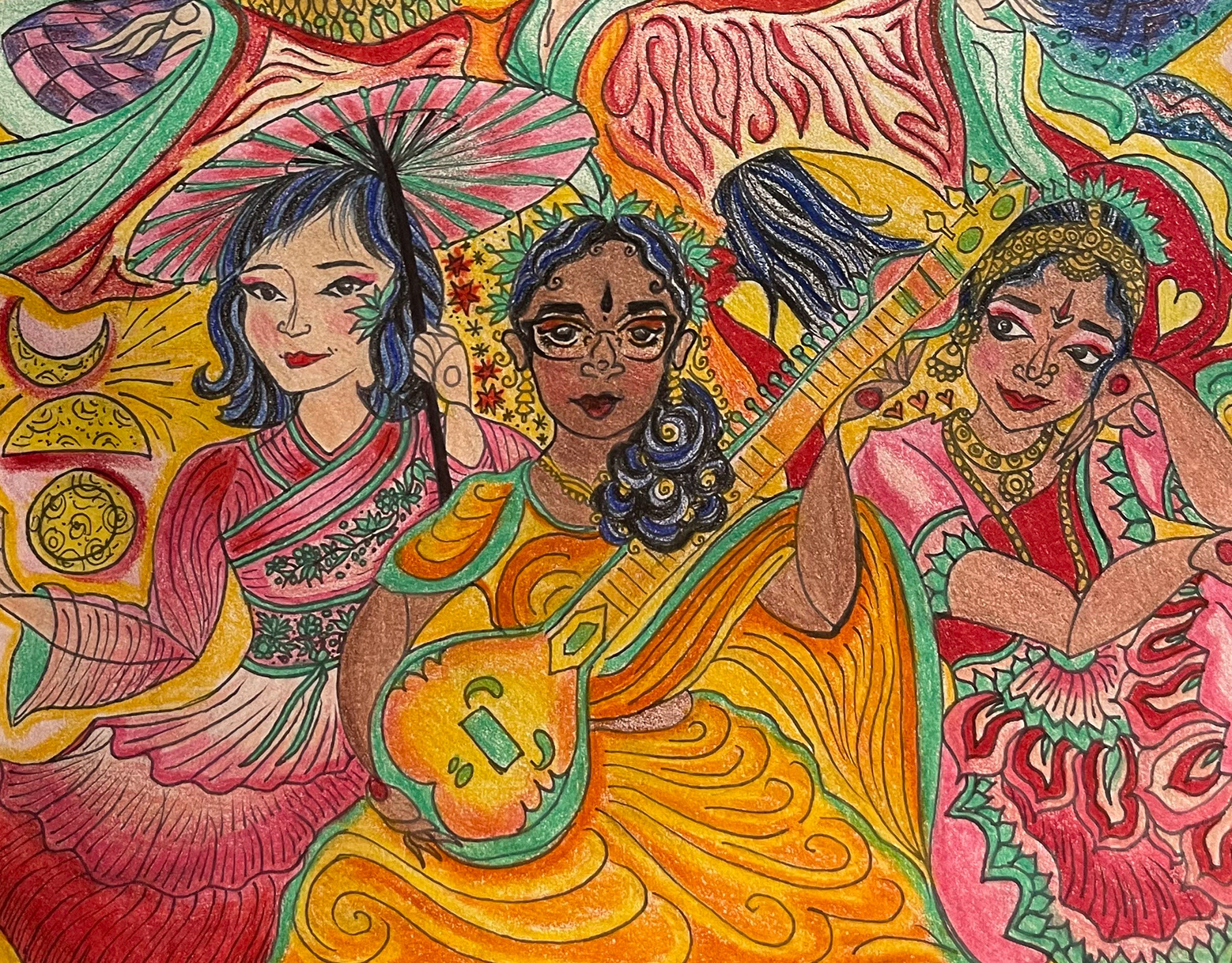
“Indo-Chinese Classical Dance" (2024)
Drawn with colored pencil and ink based on ink outline (see "Draft" in Poster section of portfolio). Each dancer is based on reference photographs of traditional Chinese classical dance costumes and traditional Indian classical dance/music costumes (Bharatanatyam, Odissi, Carnatic). Motifs associated with each culture, including a parasol and a sitar, are included. A bold, gradient color scheme which suits both cultures was applied to the clothing, hair, and backdrop. Each figure's costume, makeup, hairstyle, and accessories is distinct. Figures are arranged and layered on the poster to show people sharing classical arts and cultural spaces with each other. Motifs of the moon and the stages of love, which was the showcase theme, is included to the bottom left (moon phases) and bottom right (small hearts). Symmetry and balance was achieved by keeping figures in parallel poses and parallel colors. Finally, the cursive script used for the description stands in contrast with the showcase information, title, and the dance clubs' names (Mei-Kala). A bold, curved script was used to match the curves and angles of the performers' bodies.

"Umbrella Buddies" (2020)
Drawn with colored pencils and ink. This illustration is of a green songbird and a squirrel clutching an umbrella for them to share under pouring raindrops and snowflakes. All elements of this piece are drawn stylistically, with curved shapes, looped lines, and zig-zagged puddles. A warm color scheme was used for the squirrel and cool tones were used for the songbird. Both are wrapped in similar yellow scarves, and both have tilted, black eyes. The shapes of their bodies are brought out through repetition in linework, and repetition is also seen in the patterns of rain and snow. The umbrella handle tapers down to a few dots, as though it is made of a twig. The mood of the piece is meant to be cheerful, festive, and merry. An ink outline is provided below (scroll down).

"Portrait of a Russian Girl" (2016)
Drawn with pencil. The focus of this piece was to draw human eyes, brows, and a nose in accordance to correct proportions and realism. Note the shading, detail in the pupils, and how color is shown despite its absence.